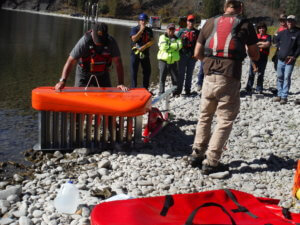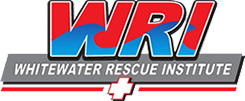Inland Spill Response
Inland oil spill response often involves moving water and presents a unique set of challenges for responders. WRI offers state of the art and innovative inland oil spill response training in our Swiftwater Spill Response Technician courses. Responder safety and managing risk during fastwater spill response are our top priority at WRI. Safety officers must be well versed in hazards presented by moving water and develop a safety action plan for responders. Responders should wear appropriate PPE including well fitted life jackets, know upstream, downstream and self-rescue safety measures, and be aware of local hazards and how to avoid entrapment situations. Establishing an effective communications plan and following chain of command through the ICS are important steps in helping responders work more safely and efficiently. An emergency plan informs responders about the location of First Aid Kits, how to contact EMS personnel, and the route and response times for emergency services and the hospital in the event of an evacuation.
Fastwater Spill Response : Boom Deployment in Rivers
Let’s talk boom. I often work as a deckhand on drills and responses so end up handling a lot of boom. Bundled boom is heavy and awkward to carry so the more gloved hands the better to get it out of the trailer and in position to deploy. A little preplanning goes a long way here. Responders who know they are going to put a lot of boom out often pre-connect it and carefully snake-load it on a trailer so it’s ready for fast deployment.
Fastwater boom deployment is one of the challenges requiring teamwork, careful risk management, communication and hopefully, practice. We need to carefully evaluate the booming strategy and current conditions. Shore-based anchors attached to boom can end up being under a lot of tension. Anticipate the line of fire and potential anchor failure and keep responders in the clear.

We use boom vanes for fastwater spill reponse when conditions are right. They are a great tool for deflection or collection strategies that can allow boom deployment in fastwater without a midstream anchor or boat. Many inland spill responses involve rivers too wide for boom to go all the way across the channel. Boom vanes are a great option to have in this situation. Make sure anchors are solid and test the boom vane in the current . Remember this rule of thumb for using boom vanes for collection strategies. If deploying 100 feet of boom, set your boom vane anchor 200 feet above your downstream anchor ( or 100′ above the end of your boom).
Jet boats are a great resource for boom deployment and so are proficient jet boat drivers. Towing boom in fastwater is dynamic and risky so everyone needs to pay attention, communicate and be careful. Never wrap a loop of rope around your hand and never step in a bight. Watch out for pinch points and have a back up plan if you need to release the boom. Connecting boom midstream requires practice and teamwork. It’s often easiest to get the boom out of the water to make the connection. We regularly use boom deflectors to prevent bellying in current and hold the boom in position.

Inland Oil Spill Response Safety and Teamwork
Work as a team, make sure your team understands the plan before you move, think of what the worst thing that could happen is -and then take preventative measures or have a back-up plan. Don’t be afraid to ask other responders, “What’s the worst thing that could happen here?”, before you act.
Response strategies are often something somebody put in a response plan but never actually practiced. Often strategies don’t account for variables such as changing river levels or limited personnel. The only way to know if an an inland spill response strategy will work is to try it. Only then will your team know what challenges arise in it’s implementation. Like in all emergency response, the point is to attempt safely so that no responders get hurt. WRI’s Inland Spill Response Training is a great way to gain valuable experience and skill from experience instructors.
“Whether you are a river-rookie or an experienced boater, WRI tailors their classes to what you need to learn in a fun and challenging environment. Their scenario based teaching approach creates an electric learning atmosphere where you feel like you are in actual river rescue situations. I would recommend them to anybody!”
